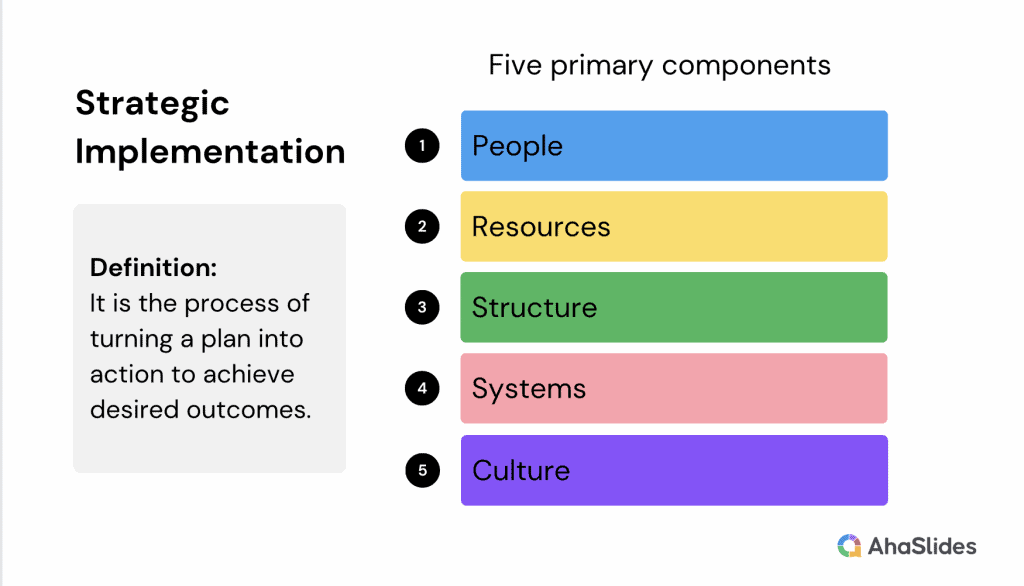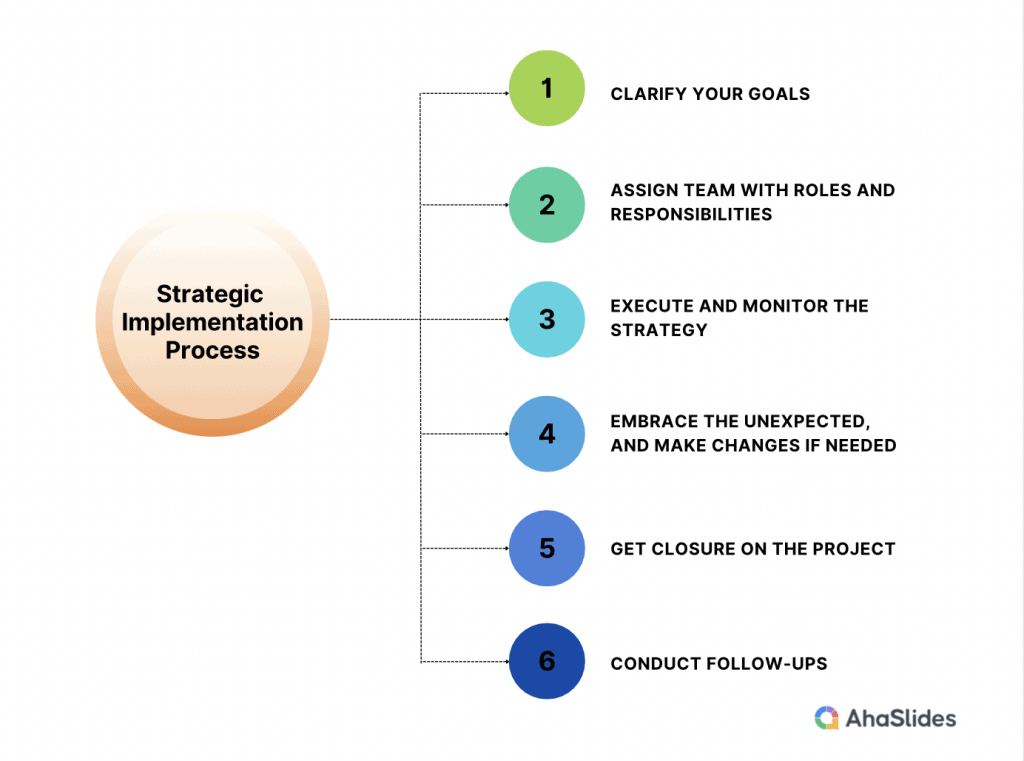A research conducted by Harvard Business School pointed out that about 90% of organizations fail in the implementation step of their well-articulated strategies.
Strategic implementation is the fourth step of the strategic management process and it is the art of getting things done. It usually is looked down compared to other strategic management's phases due to the existing gap between strategic planning and execution.
Apparently, the plan is just a paper that has no impact on the businesses if the strategy implementation isn't going right.
So, what is the meaning of strategy implementation, what are strategy implementation steps, and how to overcome its challenges? They all will be discussed in this article, so let's dive in!

Table of Contents
- What is strategic implementation?
- Why is strategic implementation important?
- What are the 6 stages of strategic implementation?
- What is an example of strategic implementation?
- What are the issues in strategy implementation?
- How to overcome challenges in strategic implementation
- Frequently Asked Questions
- Bottom Line
What is strategic implementation?
Strategic implementation describes the strategy of turning plans into action to achieve desired outcomes, especially the long-term goals of the organization. It is the set of activities where the strategic plan is changed into strict performance in an organization.
A considerate and meticulous planning and project management skills are required. There are five primary components such as people, resources, structure, systems, and culture which support the implementation of the strategy.
An example can be executing a new marketing plan to boost sales of the company's products or adjusting your employee evaluation process by integrating interactive presentation software like AhaSlides into your organization in the next few years.

Why is strategic implementation important?
It is important to note that strategic implementation is one of the most crucial parts of any project and brings a lot of benefits to organizations due to the following reasons:
- It helps organizations achieve objectives.
- It is the perfect tool to judge whether the formulated strategy is appropriate or not.
- It helps to determine the loopholes and bottlenecks in strategy formulation and controlling.
- It helps measure the efficacy of management processes and practices.
- It helps organizations build core competencies and competitive capabilities
What are the 6 stages of strategic implementation?
The strategic implementation follows 7 steps, from setting clear goals to conducting follow-ups, these stages serve as a roadmap for organizations to navigate the complex terrain of strategy execution. Let's check out what managers have to do in each step!

Stage 1: Clarify your goals
Like a spark that ignites a blazing fire, clear goals fuel the passion and determination required for successful implementation. They serve as guiding beacons, directing efforts towards a common vision.
By setting specific, measurable, attainable, relevant, and time-bound (SMART) goals, organizations ignite the flame of inspiration within their teams. In parallel, identifying key variables and factors that shape success provides a compass for navigating the turbulent waters of implementation.
Stage 2: Assign team with roles and responsibilities
No masterpiece is created by a solitary artist; it takes a symphony of talents working harmoniously. Similarly, identifying roles, responsibilities, and relationships is the art of weaving a tapestry of collaboration and synergy.
By clearly defining who does what and how they interconnect, organizations create a vibrant ecosystem that fosters innovation, trust, and collective excellence. Embracing the power of teamwork, they unleash the true potential of their people.
Note that entrusting each employee with meaningful tasks aligned with their skills and passions, organizations ignite a sense of ownership, purpose, and personal growth. This unleashes a force capable of moving mountains, propelling the strategy forward with unwavering determination.
Stage 3: Execute and monitor the strategy
With a well-defined strategy and delegated tasks, organizations embark on executing their implementation plan. During this stage, it is crucial to establish a schedule so you can frequently update the status of your progress.
Regular assessments and feedback loops help identify bottlenecks, track milestones, and ensure alignment with the strategic objectives.
Continuous support and guidance provided to the teams further enhance their motivation and effectiveness in delivering results.
Stage 4: Embrace the unexpected, and make changes if needed
In the unpredictable landscape of strategic implementation, unexpected twists and turns often emerge. Yet, it is in these moments that true resilience and adaptability shine. Organizations must embrace the unexpected with open arms and view challenges as opportunities for growth.
By swiftly taking corrective action, adjusting their steps, and revising their strategies, they not only conquer obstacles but emerge stronger and more agile than ever.
Stage 6: Get closure on the project
As the implementation nears completion, it is important to achieve closure on the projects or initiatives undertaken. This stage also involves obtaining agreement on the outputs and results obtained, ensuring alignment with the organization's strategic intent.
Stage 7: Conduct follow-ups
Evaluation is needed at the end of the strategic implementation. You can conduct a post-mortem or retrospective or review of how the process went. With a right feedback and reflection process, it creates a chance for managers and team to identify lessons learned, celebrate successes, and identify areas for improvement, illuminate the path ahead and inspire future endeavors.
What is an example of strategic implementation?
There are plenty of good strategy implementation examples in the business context. CocaCola, Tesla, or Apple are leading examples in their industry.
Coca-Cola's strategic implementation encompassed consistent messaging and global reach. Through cohesive branding and memorable slogans like "Open Happiness" and "Taste the Feeling," Coca-Cola united their marketing efforts across diverse markets. This global approach allowed them to cultivate a sense of familiarity and connection, making Coca-Cola a beloved and recognizable brand worldwide.
Tesla is another exemplary case of strategic implementation. Tesla's strategic implementation began with a clear goal of creating high-performance electric vehicles that would surpass traditional gasoline-powered cars. They positioned themselves as a brand synonymous with cutting-edge technology, superior range, and remarkable performance.
Apple's execution was marked by meticulous attention to detail and a focus on delivering products that seamlessly integrated hardware and software. The release of game-changing innovations such as the iPod, iPhone, and iPad showcased their commitment to excellence. Apple's dedication to delivering a user experience like no other sets them apart, captivating the world and revolutionizing entire industries.
What are the issues in strategy implementation?
Though many organizations highly invest time and money to formulate great strategies, not all of them are really successful. Here are the six top reasons why strategy implementation might fail:
- Poor leadership and lack of communication
- Lacks clear objectives or doesn't make any business sense.
- Hasn’t properly figured outthe organization's current situation and capabilities
- Fails to engage the right people, or lack of effective employee training
- Allocates insufficient time and budget
- Overly complex or too vague to understand
- Fails to follow-ups such as review, assessment, or performing necessary changes
How to overcome challenges in strategic implementation
If you are looking for ways to fix a flawed strategy implementation and bring value to your business, here are some strategies for ithe mplementation of a project you shouldn't miss:
- Establish open and frequent communication
- Foster a supportive environment where honesty is valued and encouraged
- Ensure clarity in strategic objectives, roles, responsibilities, and expectations
- Offer team support and provide guidance, training, or additional assistance when required.
- Provide the right tools for the job
Frequently Asked Questions
What is the purpose of implementation?
It aims to put plans into action, with a combination of various planned, intentional activities for achieving specific objectives.
What are the 5 stages of strategic management?
The five stages of the strategic management process are goal-setting, analysis, strategy formation, strategy implementation and strategy monitoring.
What are the factors affecting strategy implementation?
The 5 key factors for successful strategy implementation are introduced as follows:
- Leadership and clear direction
- Organizational alignment
- Resource allocation
- Effective communication and engagement
- Monitoring and adaptation

References: Harvard Business School Online | MGI | Qsstudy | Asana








